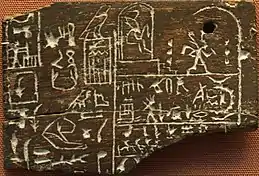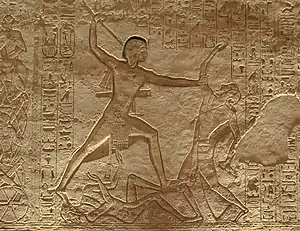| Branch in hieroglyphs | ||
|---|---|---|
The ancient Egyptian Branch hieroglyph, also called a Stick,[1] is a member of the trees and plants hieroglyphs.
The branch is an Egyptian language biliteral with the value (kh)t, (khet)-(ḫt); it is an ideogram-(determinative),[2] for wood, tree, and the linear measure (=100 cubits).[3] The hieroglyph is described as a branch without leaves.
Iconographic usage
Pharaonic usage
Pharaoh Nectanebo II used the branch hieroglyph for his Nomen name of Nakhthoreb, "Strong is His Lord, Beloved of Hathor".
Pharaoh Nectanebo I's nomen was Nekhtnebef, "Strong is His Lord."
Old Kingdom usage

Two labels are known from the Old Kingdom showing usage of the branch hieroglyph, one by Pharaoh Den, one by Semerkhet. The usage on the labels shows the branch hieroglyph in a more archaic form.
Rosetta Stone usage of branch--"khet"
In the 198 BC, Rosetta Stone the branch hieroglyph is used six times, lines R1 combined with N23-(the Nubayrah Stele), R5, R6, R9, R13 and R14.[4]
The Rosetta Stone usage of the hieroglyph is somewhat distinctive:
- line R1–
"kh-t",


".... Were brought some of them (rebels) into White Wall (Memphis, Egypt-"Aneb-Hetch-t"), at the festival of the receiving behold of the kingdom from his father, slaying by placing [them] upon stakes[s]."[5]
- line R5–
"nekh-t" for "might"-(Nike, as the goddess of Victory: Greek Nike)





".... As a reward for-(using "ancestry" hieroglyph), these things have given him (Ptolemy V) the gods and goddesses: victory, might, life, strength, health, (AUS) and everything good to the fullest possible extent of them;..."[6] - line R9–Used in a prepositional phrase: "em-khet", literally vertical letter "M"-(vertical form of Gardiner U31, unlisted-
) with the branch hieroglyph.
(horiz bakers bread cooking tool) - lines R13/R14–
-"khet-tu", (both lines reconstructed except "-tu" of R13). "To inscribe", upon the priest's rings, and on the Rosetta Stone, (i.e. the Decree of Memphis (Ptolemy V)), in the three scripts: Egyptian hieroglyphs, Egyptian Demotic, and the Greek language.





(ros line13)
Variant forms
One common variant form of the branch hieroglyph is combined with the tree, M1,
, and
in a ligature, Gardiner Aa40,
, (there is also an Aa41 with the tree).
Example words
Ramses II at Abu Simbel
| "N-(kh)-t"-(Nekht) Strength Victory Might in hieroglyphs | ||
|---|---|---|
A wall relief inside the Great Temple of Abu Simbel shows Ramses II smiting Libyans. Young Ramses in a chariot is shown on the left, bow drawn, charging into Syrian ranks.[8] On the right he is standing over one prone Libyan fighter, and is smiting another with a mace-club in his right hand, while holding the Libyan fighter with his extended left arm. The extensive military scenes are commemorating his military victories,[9] and the hieroglyphic text explains the specifics of the events.
Above the clasped Libyan fighter is one column of text, (out of a series of about 15 columns, variable in height), describing the "victory-buildings", the strongholds that the captives will be confined in. The text explains that Ramses and the Egyptian army went after three groups of rebels, and then confined them.

Block statue of Bakenkhonsu
| ||||||||||||
| Column 2 title of Bakenkhonsu, etc. in hieroglyphs | ||||||||||||
|---|---|---|---|---|---|---|---|---|---|---|---|---|
Ramesses II's 1st Order priest Bakenkhonsu, a High Priest of Amun-Ra of the 13th century BC has a nearly undamaged block statue.[13] The statue presents four columns of hieroglyphs on its frontal face, and a horizontal inscription on the plinth.[14] The vertical texts of hieroglyphs cover about fourteen vertical compositional blocks. (see here )
The first column addresses the gods: Amun-Ra, Tem-(Atum), then Horus, Mut and Khonsu. Column 2 uses the branch hieroglyph to state the title he assumes. The sentence starts as follows:
- "...Title permanent in Uas-t, DjedU, "Strength (of) Eternity" by Soul of Ra-forefront, Emeer-(governor), (of) God-Priests..."
![D21 [r] r](../I/hiero_D21.png.webp)

(title) ![Y5 [mn] mn](../I/hiero_Y5.png.webp)


(permanent)

(for) 


(cityThebes,Egypt) 




(the cemetery of West DjedU)




(title StrengthEternal) 


(Eternal)

(by) 

(soul) 
(of) ![D21 [r] r](../I/hiero_D21.png.webp)


(godra) 
(forefront) 
(superintedant) 



(god priests)
 An obelisk of Thutmose III in Istanbul
An obelisk of Thutmose III in Istanbul Ivory label of Pharaoh Semerkhet
Ivory label of Pharaoh Semerkhet.jpg.webp)
 Foreleg of ox being offered.
Foreleg of ox being offered.
See also
References
- ↑ Kamrin, 2004. Ancient Egyptian Hieroglyphs: A Practical Guide, Appendix C, Key to Sign List, M. Vegetation, M3, stick, p. 241.
- ↑ Schumann-Antelme, and Rossini, Biliterals, (B1-B83), B23, khet, p. 118-119.
- ↑ Schumann-Antelme, and Rossini, p. 118.
- ↑ Budge, 1989, (1929), The Rosetta Stone, p. 147-169.
- ↑ Budge, 1989, (1929), p. 147.
- ↑ Budge, 1989, (1929), p. 152-3.
- ↑ Budge, 1989, (1929), p. 155.
- ↑ Time-Life Books, 1993. Ramses II: Magnificence on the Nile, "From the series of reliefs...", photo caption, p. 28, (28-29).
- ↑ Time-Life Books, 1993. p. 28, (28-29).
- ↑ Wikimedia Commons photo, Egypt-Abu Simbel (Ramses II with Libyan).
- ↑ Betrò, Hieroglyphics: The Writings of Ancient Egypt, "Mason", Gardiner A35, p. 40.
- ↑ Libyan smiting relief, Great Abu Simbel Archived June 8, 2011, at the Wayback Machine
- ↑ Dodson, 2001. The Hieroglyphs of Ancient Egypt, p. 30.
- ↑ Dodson, 2001, p. 30.
- Betrò, Maria Carmela. Hieroglyphics: The Writings of Ancient Egypt, c. 1995, 1996-(English), Abbeville Press Publishers, New York, London, Paris (hardcover, ISBN 0-7892-0232-8)
- Budge, The Rosetta Stone, E.A.Wallace Budge, (Dover Publications), c 1929, Dover edition(unabridged), 1989. (softcover, ISBN 0-486-26163-8)
- Dodson, 2001. The Hieroglyphs of Ancient Egypt, Aidan Dodson, c 2001, Barnes & Noble Books. (hardcover, ISBN 0-7607-2664-7 )
- Kamrin, 2004. Ancient Egyptian Hieroglyphs: A Practical Guide, Janice Kamrin, c 2004, Harry N. Abrams, Publisher, (Photos or graphics of 73 Ancient Egyptian objects analyzed-(Exercises-(51), Objects)) (hardcover, ISBN 0-8109-4961-X)
- Schumann-Antelme, and Rossini, 1998. Illustrated Hieroglyphics Handbook, Ruth Schumann-Antelme, and Stéphane Rossini. c 1998, English trans. 2002, Sterling Publishing Co. (Index, Summary lists (tables), selected uniliterals, biliterals, and triliterals.) (softcover, ISBN 1-4027-0025-3)
- Time-Life Books, 1993. Ramses II: Magnificence on the Nile, Time-Life Books editors, Time-Life Books, Alexandria, Virginia. (hardcover, ISBN 0-8094-9012-9)